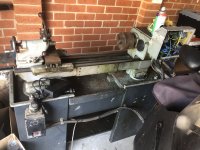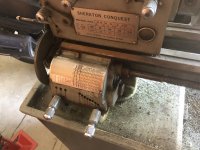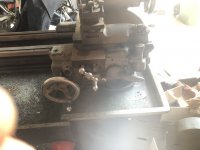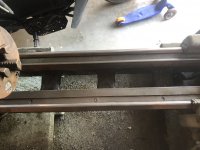Yes, I was thinking if I got that system, I'd use it for everything .... painting, sanding, welding ... etc.Having been around quite a bit of asbestos and masonry dust, etc, way back when I was a youngster helping my plumber father, I try to be very vigilant regarding anything I breath in. I mask up even when painting the house, even though the doors are wide open.

You are using an out of date browser. It may not display this or other websites correctly.
You should upgrade or use an alternative browser.
You should upgrade or use an alternative browser.
Tool Talk
- Thread starter jo proffi
- Start date
Anyone know much about lathes, or can recommend a good forum for assistance? I've got one that needs a quite a bit of work, and don't really know where to start. Trying to assess if it's too far gone and I'm better off cutting the losses.
My oldest son is a fitter and turner.Anyone know much about lathes, or can recommend a good forum for assistance? I've got one that needs a quite a bit of work, and don't really know where to start. Trying to assess if it's too far gone and I'm better off cutting the losses.
I would say unless it's a high quality lathe, depending on how much is wrong with it, you could be better off cutting your losses.
His personal lathe is an old 1950s British made 6' bed Faircut.
Of course it all depends on what you plan on machining, and to what tolerances you are going to be machining things to?
They have brand new Chinese made lathes at his workplace that aren't as accurate as some of the the 50 year old Pommy ones that they still have in service.
Here is a couple, I'm not on any of these, but i'm sure you will find the help you need. Also YouTube has lots of info there as well.
 www.homemodelenginemachinist.com
www.homemodelenginemachinist.com
Home Model Engine Machinist Forum
Home model engine machinists & makers forum. Model engine making forums for engine plans, castings, CAD, CNC designs, lathe, Stirling, boilers & steam.
 www.homemodelenginemachinist.com
www.homemodelenginemachinist.com
Practical Machinist - Largest Manufacturing Technology Forum on the Web
Worlds largest machinist, CNC and manufacturing forum
www.practicalmachinist.com
Last edited:
Any chance of some photos, close-ups, description of condition, rust, obvious wear of the bed, etc?Anyone know much about lathes, or can recommend a good forum for assistance? I've got one that needs a quite a bit of work, and don't really know where to start. Trying to assess if it's too far gone and I'm better off cutting the losses.
I am sure there are people on this forum that would give you an opinion, maybe even someone with actual knowledge
If the problems are mechanical, ie, drive system, motor, etc, then it may be repairable.
If the beds are worn badly, that may be difficult to get repaired, although there are always good engineers around to carry out some very good machining. This would cost, unless you maybe found someone who sees a vintage restoration as a hobby, and would be prepared to do it for low cost.
As with anything, if you can do a lot of the repair yourself, and only paying for the specialist machining, it will be more feasible.
But, as said above, these days it may be more economical to buy a new "cheapie" (but not too cheapie), my go to would be someone like this company Hare & Forbes, with a physical presence in 4 states of Australia, and a reasonable reputation.
Buy Lathes Online - Australia - Hare & Forbes Machineryhouse
Become a Machineryhouse Mate! Australia's leading supplier of Engineering, Metal & Wood working machinery. Buy online or in-store.
Cheers.
real lathes still cost big.... an expensive Oriental is every bit as good as old time expensive Euro, or Aussie for that matter. It's in the hobby zone that the Asian machines have made a big impact, but if you don't wanna spend much, be prepared to hunt the forums and fix the problems. 
The one cheap exception, Taig, seems to have disappeared from Oz. A US import that they almost gave away, as kits, when the USD was ultra low here.
My suburban shed lathe is an Aussie Advance, likely as old as me, and a good exercise for little cost to rehabilitate....
Big or small, new or old, the same rules on expenditure apply, you'll spend lots more on tooling than you thought you might - likely much more than the lathe itself !!
Bob
The one cheap exception, Taig, seems to have disappeared from Oz. A US import that they almost gave away, as kits, when the USD was ultra low here.
Lathes and Milling Machines
Greetings I'm thinking of setting up a small workshop to fiddle around with metal working. I have a bench drill and and thinking of getting a lathe and milling machine but I really don't know what I should be looking for. The most I'd use it for is to work on cars and lawn mowers so I don't...
www.aussiefrogs.com
Tool Talk
I don't mislay car tools, as I count them back. What disappears, sometimes for years and even forever, are hammers, chisels, screwdrivers, garden implements - anything needed for household stuff. My ability to make these vanish is supernatural. Now we know your superhero power.
www.aussiefrogs.com
Bob
Last edited:
Bob, you have opened yourself up for all sorts of witty, cruel, humorous, cutting, rude, disparaging and ageist remarks.
Where do you want to start?

Brendan.
ps They still have a stockpile of Black Coal inside Newport outside of Steam Rail Victoria, just saying.
Where do you want to start?

Brendan.
ps They still have a stockpile of Black Coal inside Newport outside of Steam Rail Victoria, just saying.
operating railway workshop when I worked there.... the museum was in it's infancy.... and we drove cars from the 50's, so, yep, I must be getting on a bit.
Work hard fellas and pay your taxes, I enjoy spending my pension
Bob
Work hard fellas and pay your taxes, I enjoy spending my pension
Bob
Dumb question.
Were you at Newport when Alstom did the the Xtrapolis upgrade?

Brendan.
ps Can you still paint a straight line for a car park?
Were you at Newport when Alstom did the the Xtrapolis upgrade?

Brendan.
ps Can you still paint a straight line for a car park?
dunno how many policemen are at Newport, but in my time the sergeant was a big bloke who provided instant retribution for miscreant kids - and threatened to tell your 'old man' what you were up to.... 
We didn't need lines in the car parks, also difficult to maintain on crushed rock. If you parked incorrectly there was was a large forklift that was used to correct inconsiderately parked vehicles.
Bob
We didn't need lines in the car parks, also difficult to maintain on crushed rock. If you parked incorrectly there was was a large forklift that was used to correct inconsiderately parked vehicles.
Bob
It's a Sheraton Model A.Any chance of some photos, close-ups, description of condition, rust, obvious wear of the bed, etc?
I am sure there are people on this forum that would give you an opinion, maybe even someone with actual knowledge
.
If the problems are mechanical, ie, drive system, motor, etc, then it may be repairable.
If the beds are worn badly, that may be difficult to get repaired, although there are always good engineers around to carry out some very good machining. This would cost, unless you maybe found someone who sees a vintage restoration as a hobby, and would be prepared to do it for low cost.
As with anything, if you can do a lot of the repair yourself, and only paying for the specialist machining, it will be more feasible.
But, as said above, these days it may be more economical to buy a new "cheapie" (but not too cheapie), my go to would be someone like this company Hare & Forbes, with a physical presence in 4 states of Australia, and a reasonable reputation.
Buy Lathes Online - Australia - Hare & Forbes Machineryhouse
Become a Machineryhouse Mate! Australia's leading supplier of Engineering, Metal & Wood working machinery. Buy online or in-store.www.machineryhouse.com.au
Cheers.
Mechanically, it seems ok (no rust, bed seems ok, some play in spindle controlling 'horizontal movement' along bed), though electrical cables have all been cut, no key and I think the emergency stop button may not be functional. Also, the motor (which I removed for transport) has a dent and apparently made 'bad noises' last time it was run. Hoping that was due to the dent impeding it spinning. Still unsure if it's 1 or 3 phase power. Any easy way to tell?
I figure the first thing to do would be to try and reconnect all the wiring cables, or am I better off buying new cables as a whole and cutting to length?
Attachments
Looks ok to me, looks like its got potential, like said above, all depends on what you are going to do with it.It's a Sheraton Model A.
Mechanically, it seems ok (no rust, bed seems ok, some play in spindle controlling 'horizontal movement' along bed), though electrical cables have all been cut, no key and I think the emergency stop button may not be functional. Also, the motor (which I removed for transport) has a dent and apparently made 'bad noises' last time it was run. Hoping that was due to the dent impeding it spinning. Still unsure if it's 1 or 3 phase power. Any easy way to tell?
I figure the first thing to do would be to try and reconnect all the wiring cables, or am I better off buying new cables as a whole and cutting to length?
As far as the motor goes whether it is a 1 or 3 phase, look on the motors name plate, should tell you there.
take some piccies of the wiring .... is it a variable speed controller? the motor should show a wiring diagram. if it mentions star/delta, its 3 phase, if you just have two wires, its going to be single phase. You might need run a vcd if its 3phase.
It's a Sheraton Model A.
Mechanically, it seems ok (no rust, bed seems ok, some play in spindle controlling 'horizontal movement' along bed), though electrical cables have all been cut, no key and I think the emergency stop button may not be functional. Also, the motor (which I removed for transport) has a dent and apparently made 'bad noises' last time it was run. Hoping that was due to the dent impeding it spinning. Still unsure if it's 1 or 3 phase power. Any easy way to tell?
I figure the first thing to do would be to try and reconnect all the wiring cables, or am I better off buying new cables as a whole and cutting to length?
Check the basics first (motor all good, take care, electrical stuff, etc, you know the drill).
3 phase motors can be rewired to run on single phase or you can go get a cheap VFD (variable frequency drive) - which is what I would do.
After that, just clean the whole thing a bit, put it together, oil it and run it.
Try to cut something with it and see what happens. The lathe will tell you if anything is wrong and what. You just need to read it. Just go simple steps, one at a time. Cut something long and soft like plastics or whatnot (even wood) and measure. Do you get a taper? is it straight? Do you get any vibrations? Chatter? Does it cut freely or does it struggle? And so on.
Don't worry about intricacies such as bed wear and such. Have a look online see how to align things a bit to get you close to the best the machine can do and use it a little bit. You will soon learn its shortcomings.
Forgot to say, get some reliable, good quality measuring implements, maybe a micrometer first. Pay as much as you can afford the first time, or you will pay many times and many times more. Mitutoyo is the go to brand, ebay has a lot of their stuff for much better prices than our shops.
A vernier caliper won't be enough to suss out problems with the lathe alignment.
Once you are ready, a dial test indicator is next (again, about 100 bucks should get you a Mitutoyo 1/100 - that is enough for the home gamer).
And remember, most of the expenditure will be tools. Whatever you paid for the lathe, it will be about 10 times that in tools. Depending on how much you use it and what for.
Last edited:
Looks to be an ideal starting point for a reasonable light hobby lathe. Main thing is to ensure all machined surfaces are clean and lightly oiled, as well as spindles and screw leads. It is handy to have an electrician mate for advice on the condition of the motor and its suitability to drive the lathe (Horse power/capacity and perhaps a variable controller as suggested and that it fits in which your electrical supply, much easier if you can simply plug it in to a power point!) Get all that right and you are on your way.
Ken
Ken
the VFD should also allow for speed control. that would be the goCheck the basics first (motor all good, take care, electrical stuff, etc, you know the drill).
3 phase motors can be rewired to run on single phase or you can go get a cheap VFD (variable frequency drive) - which is what I would do.
After that, just clean the whole thing a bit, put it together, oil it and run it.
Try to cut something with it and see what happens. The lathe will tell you if anything is wrong and what. You just need to read it. Just go simple steps, one at a time. Cut something long and soft like plastics or whatnot (even wood) and measure. Do you get a taper? is it straight? Do you get any vibrations? Chatter? Does it cut freely or does it struggle? And so on.
Don't worry about intricacies such as bed wear and such. Have a look online see how to align things a bit to get you close to the best the machine can do and use it a little bit. You will soon learn its shortcomings.
Forgot to say, get some reliable, good quality measuring implements, maybe a micrometer first. Pay as much as you can afford the first time, or you will pay many times and many times more. Mitutoyo is the go to brand, ebay has a lot of their stuff for much better prices than our shops.
A vernier caliper won't be enough to suss out problems with the lathe alignment.
Once you are ready, a dial test indicator is next (again, about 100 bucks should get you a Mitutoyo 1/100 - that is enough for the home gamer).
And remember, most of the expenditure will be tools. Whatever you paid for the lathe, it will be about 10 times that in tools. Depending on how much you use it and what for.
the VFD should also allow for speed control. that would be the go
Yes, they do but it is at the expense of low end torque. The lathe itself however might have some useable gearing down low.
It looks a decent enough unit for hobby purposes. Good range of speeds, gear box is better than change gears for adjusting feed speed, bed look OK, big enough for hobby purposes, a single screw for thread cutting and power feeds is all you need.
Please show us some pictures of the wiring and motor. If the existing motor is in fact 3 phase, you will find a single phase motor will drive it so the easy thing would be to replace it with a single phase. My guess is that if a dint in the motor casing resulted in the motor making funny noises that it is probably single phase. There is more wiring and switchgear inside a single phase motor than in a 3 phase motor.
Roger
Please show us some pictures of the wiring and motor. If the existing motor is in fact 3 phase, you will find a single phase motor will drive it so the easy thing would be to replace it with a single phase. My guess is that if a dint in the motor casing resulted in the motor making funny noises that it is probably single phase. There is more wiring and switchgear inside a single phase motor than in a 3 phase motor.
Roger
bit better than a 'light hobby lathe' I'd reckon, it's an Aussie 9" South Bend with a geared head.... just need to trust that it didn't come out of the local Tech.... 
Later ones were 10" !!
Bob
Later ones were 10" !!
Bob
Last edited:
It's a Sheraton Model A.
Mechanically, it seems ok (no rust, bed seems ok, some play in spindle controlling 'horizontal movement' along bed), though electrical cables have all been cut, no key and I think the emergency stop button may not be functional. Also, the motor (which I removed for transport) has a dent and apparently made 'bad noises' last time it was run. Hoping that was due to the dent impeding it spinning. Still unsure if it's 1 or 3 phase power. Any easy way to tell?
I figure the first thing to do would be to try and reconnect all the wiring cables, or am I better off buying new cables as a whole and cutting to length?
The dent is no doubt in the cover on the non drive end, if this is the case, the fan is most likely hitting where the dent is. Just remove the cover (there will be 3 or 4 screws holding it on) and knock the dent out and replace the cover. You can easily check the mechanical condition of the motor by spinning the shaft and listening for noises. Also check end float, a small amount is ok but you don't want to much.It looks a decent enough unit for hobby purposes. Good range of speeds, gear box is better than change gears for adjusting feed speed, bed look OK, big enough for hobby purposes, a single screw for thread cutting and power feeds is all you need.
Please show us some pictures of the wiring and motor. If the existing motor is in fact 3 phase, you will find a single phase motor will drive it so the easy thing would be to replace it with a single phase. My guess is that if a dint in the motor casing resulted in the motor making funny noises that it is probably single phase. There is more wiring and switchgear inside a single phase motor than in a 3 phase motor.
Roger



